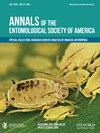Online community photo-sharing in entomology: a large-scale review with suggestions on best practices
IF 1.8
3区 农林科学
Q1 ENTOMOLOGY
引用次数: 1
Abstract
Abstract Over the past 2 decades, digital photography has grown increasingly accessible. This has ushered in a golden age of community science, where nonspecialists share natural history observations from across the globe via digital media. Importantly, these observations are accessible to researchers, who can readily share expertise directly with the community and connect observations and observers with research projects. This has fueled a rising number of publications combining specialist and nonspecialist observations, which occasionally make national and international headlines. Entomology has embraced this trend, but the scope and impact are not clear. A review of its effect on the field is therefore warranted. Herein, we review and analyze publications that incorporated information from photographs shared on photo-sharing websites. In total, 2,123 publications that incorporated information from 77 photo-sharing websites were examined. Seven websites accounted for 66% of the publication citations. 84.6% of publications focused on data from the Holarctic ecoregion (56.2% Palearctic and 28.4% Nearctic). Forty-six arthropod orders were represented, but the Big Five—Lepidoptera, Coleoptera, Hymenoptera, Hemiptera, and Diptera—accounted for 75% of all publications. We divide the publications into 28 discovery and use categories, review how community photograph data has been used within each category, and provide examples of categories utilized in nonentomology natural history fields, which we hope will provide inspiration and spur future research. We also discuss benefits and considerations when using such data—including the accuracy of identifications, inherent biases, and digital data impermanence—and suggest best practices to follow.昆虫学中的在线社区照片分享:一项大型综述及最佳实践建议
在过去的二十年里,数码摄影变得越来越普及。这开启了社区科学的黄金时代,非专业人士通过数字媒体分享来自全球各地的自然历史观察。重要的是,研究人员可以获得这些观察结果,他们可以很容易地直接与社区分享专业知识,并将观察结果和观察者与研究项目联系起来。这推动了越来越多的结合专家和非专家观察结果的出版物,这些出版物偶尔会成为国内和国际头条新闻。昆虫学已经接受了这一趋势,但其范围和影响尚不清楚。因此,有必要审查其对该领域的影响。在此,我们回顾和分析了包含照片分享网站上分享的照片信息的出版物。总共检查了2123份包含77个照片分享网站信息的出版物。7家网站占据了66%的出版物引用量。84.6%的出版物集中于全北极生态区的数据(56.2%的古北区和28.4%的新北极区)。节肢动物有46目,其中大五目(鳞翅目、鞘翅目、膜翅目、半翅目和双翅目)占所有出版物的75%。我们将出版物分为28个发现和使用类别,回顾了在每个类别中如何使用社区照片数据,并提供了在非昆虫学自然历史领域中使用的类别示例,我们希望能够为未来的研究提供启发和刺激。我们还讨论了使用此类数据时的好处和注意事项(包括识别的准确性、固有偏差和数字数据的不永久性),并提出了应遵循的最佳实践。
本文章由计算机程序翻译,如有差异,请以英文原文为准。
求助全文
约1分钟内获得全文
求助全文
来源期刊
CiteScore
4.90
自引率
0.00%
发文量
25
审稿时长
6-12 weeks
期刊介绍:
The Annals of the Entomological Society of America exists to stimulate interdisciplinary dialogue across the entomological disciplines and to advance cooperative interaction among diverse groups of entomologists. It seeks to attract and publish cutting-edge research, reviews, collections of articles on a common topic of broad interest, and discussion of topics with national or international importance. We especially welcome articles covering developing areas of research, controversial issues or debate, and topics of importance to society. Manuscripts that are primarily reports of new species, methodology, pest management, or the biology of single species generally will be referred to other journals of the ESA. The most important criteria for acceptance are quality of work and breadth of interest to the readership.

 求助内容:
求助内容: 应助结果提醒方式:
应助结果提醒方式:


